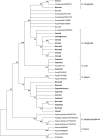Molecular investigation and phylogeny of Anaplasma spp. in Mediterranean ruminants reveal the presence of neutrophil-tropic strains closely related to A. platys
- PMID: 24162569
- PMCID: PMC3911010
- DOI: 10.1128/AEM.03129-13
Molecular investigation and phylogeny of Anaplasma spp. in Mediterranean ruminants reveal the presence of neutrophil-tropic strains closely related to A. platys
Abstract
Few data are available on the prevalence and molecular typing of species belonging to the genus Anaplasma in Mediterranean ruminants. In this study, PCR analysis and sequencing of both 16S rRNA and groEL genes were combined to investigate the presence, prevalence, and molecular traits of Anaplasma spp. in ruminants sampled on the Island of Sardinia, chosen as a subtropical representative area. The results demonstrate a high prevalence of Anaplasma spp. in ruminants, with animals infected by at least four of six Anaplasma species (Anaplasma marginale, A. bovis, A. ovis, and A. phagocytophilum). Moreover, ruminants host a number of neutrophil-tropic strains genetically closely related to the canine pathogen A. platys. The high Anaplasma spp. prevalence and the identification of as-yet-unclassified neutrophil-tropic strains raise concerns about the specificity of serological tests routinely used in ruminants and provide additional background for reconstructing the evolutionary history of species genetically related to A. phagocytophilum.
Figures




References
-
- Uilenberg G. 1997. General review of tick-borne diseases of sheep and goats worldwide. Parasitologia 39:161–165 - PubMed
-
- Bekker CP, de Vos S, Taoufik A, Sparagano OA, Jongejan F. 2002. Simultaneous detection of Anaplasma and Ehrlichia species in ruminants and detection of Ehrlichia ruminantium in Amblyomma variegatum ticks by reverse line blot hybridization. Vet. Microbiol. 89:223–238. 10.1016/S0378-1135(02)00179-7 - DOI - PubMed
Publication types
MeSH terms
Substances
Associated data
- Actions
- Actions
- Actions
- Actions
- Actions
- Actions
- Actions
- Actions
- Actions
- Actions
- Actions
- Actions
- Actions
- Actions
- Actions
- Actions
- Actions
- Actions
- Actions
- Actions
- Actions
- Actions
- Actions
- Actions
- Actions
- Actions
- Actions
- Actions
- Actions
- Actions
- Actions
- Actions
- Actions
- Actions
- Actions
- Actions
- Actions
- Actions
- Actions
- Actions
- Actions
- Actions
- Actions
- Actions
- Actions
- Actions
- Actions
- Actions
- Actions
- Actions
- Actions
- Actions
- Actions
LinkOut - more resources
Full Text Sources
Other Literature Sources
Molecular Biology Databases
Research Materials
Miscellaneous

